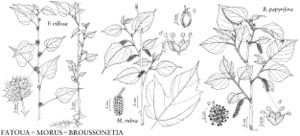Broussonetia
Tabl. Règn. Vég. 3: 547. conserved.
| Taxon | Illustrator ⠉ | |
|---|---|---|
 | Morus rubra Broussonetia papyrifera Fatoua villosa | John Myers John Myers John Myers |
Trees, deciduous; sap milky. Terminal buds surrounded by bud-scales. Leaves alternate, opposite, or whorled; stipules caducous, free. Leaf-blade ovate, lobed or entire, margins dentate; venation appearing palmate or weakly 3-veined from base. Staminate inflorescences pedunculate, cylindric spikes; pistillate inflorescences short-pedunculate, globose capitula. Flowers: staminate and pistillate on different plants. Staminate flowers: sepals 4, connate at base; stamens 4, inflexed. Pistillate flowers: sepals 4, connate, forming tube; ovary superior, stipitate, 1-locular; style unbranched. Fruits globose; each drupelet partly protruding from its enlarged calyx. x = 13.
Distribution
North America, Asia, and Pacific Islands (Polynesia)
Discussion
Species 7-8 (1 in the flora).
Selected References
None.